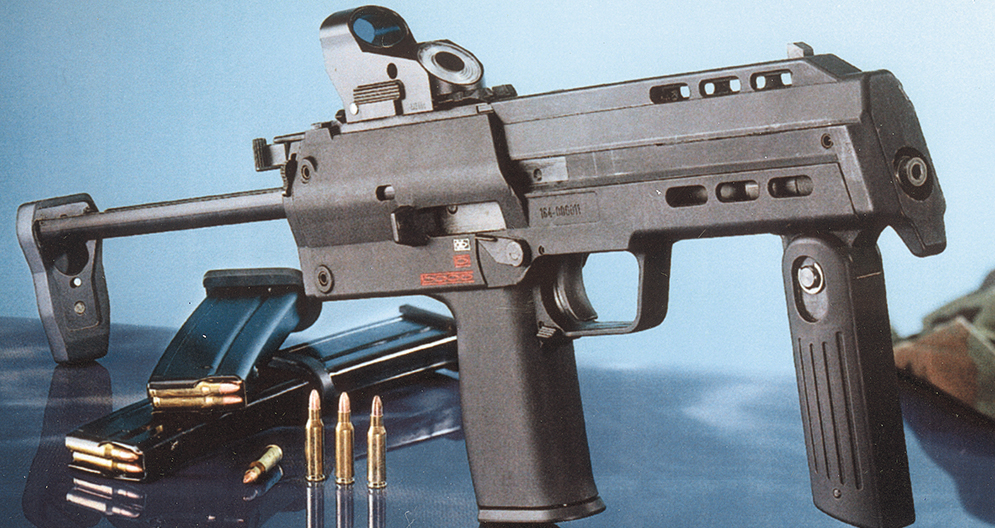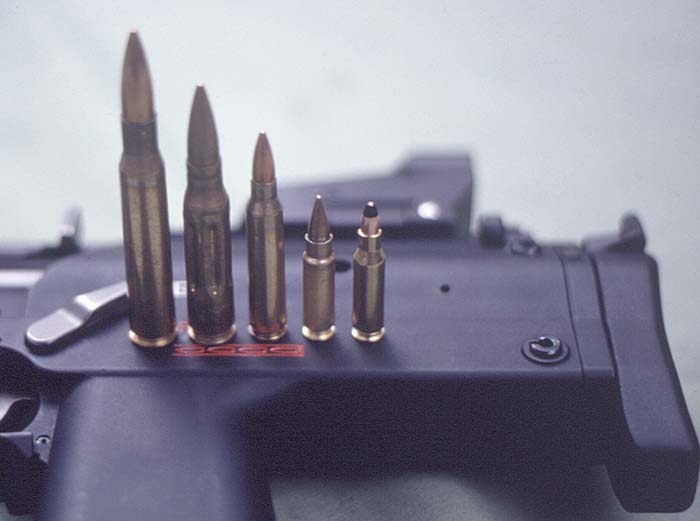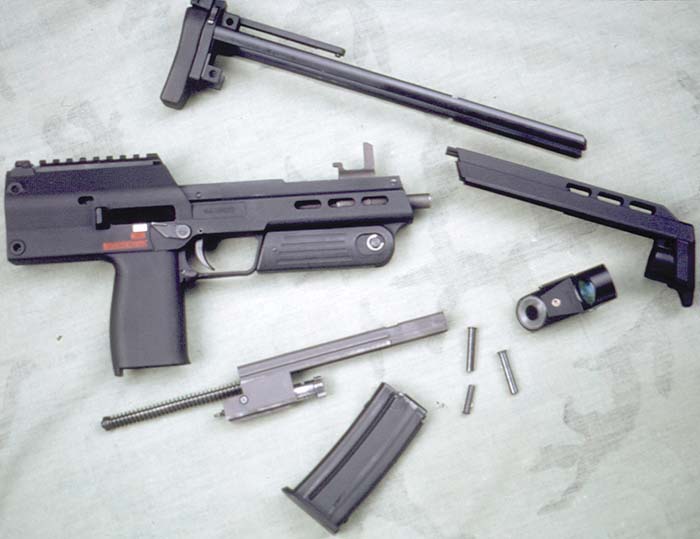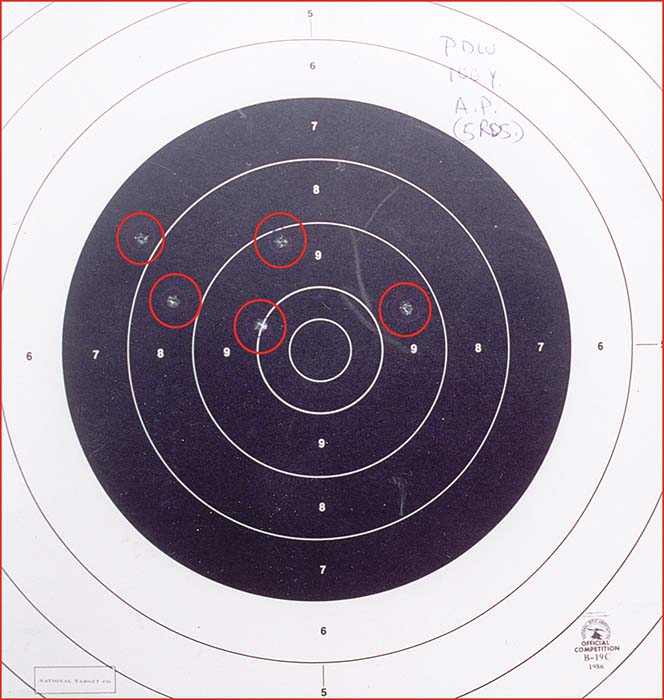
By Jim Schatz
Leaner and Meaner
While there are exceptions of course, guns and ammunition used by American military and law enforcement personnel have generally been getting smaller and lighter rather than larger and heavier during the course of the 20th century. The U.S. M4 Carbine, a lighter smaller variant of the M16A2, is now in service with many conventional military units. Compact pistols are more and more often procured for standard police uniformed issue rather than available full size handguns. The standard U.S. military service rifle cartridge has shrunk from the WWI era .30 caliber cartridge (30-06 Springfield), to the 7.62X51mm NATO (.308 Winchester) round in the early 1950’s to the current 5.56X45mm NATO cartridge commercially known as the .223 Remington. HK now offers the small 4.5 pound UMP45 submachine gun that fires the big, powerful .45 ACP slugs yet the weapon is less than half the weight of most other .45 caliber submachine guns. Even the “Ma Deuce” M2 .50 caliber heavy machine gun exists today in a lightweight high cyclic rate of fire variant. The advent of advanced lightweight materials, stronger steels and alloy metals for barrel and bolt construction, and vastly improved ammunition and bullet technology have increased the lethality and performance of today’s modern military and law enforcement firearms while at the same time lightening and lessening the load of the user.

New Start, new concept
Heckler & Koch has been working behind the scenes in their “skunk works” at their Oberndorf Germany facility on a new small Personal Defense Weapon simply called the PDW. Though primarily designed to meet current and future U.S. and European requirements for a military Personal Defense Weapon the obvious usefulness of such a weapon outside of the military becomes immediately apparent to law enforcement and special operations personnel.
To describe the new HK PDW as revolutionary as some may be tempted to do would be stretching things a bit. As a “bullet launcher” the PDW still kills by kinetic energy as small arms have been doing for centuries. It is however safe to classify this new weapon and ammunition system as a substantial development in this relatively new category of Personal Defense Weapons, a category that until recently only included the 5.7mm FN P90.
Most experts categorize a true PDW as a small easily portable weapon about the size of a machine pistol but one that shoots a non-pistol cartridge. Most PDW’s are also intended to be able to be fired using only one hand though with reduced probability of hit. Modern PDW’s are being promoted to replace handguns, pistol-caliber submachine guns and some assault rifles primarily in military support units. These personnel very seldom employ small arms in combat and when they do only for defensive purposes up close. A simple, easily portable weapon that allows for effective target engagement by lessor trained rear echelon combatants is the original role intended for the PDW. Because of the worldwide proliferation of modern hard and soft body armor today’s PDW must also penetrate protective vests and helmets in order to be effective against the aggressor underneath.
The Ammo
The HK PDW is chambered for a new proprietary cartridge developed jointly by HK and Royal Ordnance (RO), HK’s parent company and a division of BAE Systems, formally British Aerospace. RO is also the UK’s premier small arms ammunition manufacturer. The HK PDW fires a small 4.6X30mm high velocity cartridge that looks more like a small rifle cartridge than a pistol round. The overall length of the round is 1.5 inches and contains a 25-grain projectile, which reaches a muzzle velocity of 2,378 feet per second from the PDW’s 7-inch barrel. A copper-plated solid steel projectile develops @ 310 foot pounds of muzzle energy and develops recoil impulse far below that of 9mm handguns. Yet this steel core 4.6X30mm round will defeat threat (former Soviet SPETsNAZ) body armor comprised of 1.6 millimeters of titanium plating backed by 20 layers of Kevlar at ranges beyond 200 meters with sufficient residual energy to inflict lethal wounds after defeating the ballistic protection.

The “family” of 4.6X30mm ammunition currently includes eight various types of rounds many of which are still under final development. This ammo family includes a steel core military penetrator round, two types of extruded solid copper “CQB” cartridges designed specifically for use in close quarters battle were overpenetration is unwanted. One copper CQB round is being produced with a pointed tip and one with a unique “spoon nose” tip to prevent overpenetration in soft tissue or through building materials. There is also a law enforcement hollow point round that will not defeat soft body armor and dummy, blank, tracer and frangible cartridges for the weapon.
In general terms the HK PDW and its 4.6mm round are designed to provide the capabilities of a 5.56mm rifle or carbine out to ranges of just beyond 200 meters yet from a firearm that is similar in size and can actually be carried and fired like a handgun. At 100 meters the 4.6mm projectile fired from the PDW still retains more energy than a 9mm NATO ball round after perforating the threat titanium/Kevlar vest. The round will penetrate two of these former Soviet vests back to back at a range of 50 meters.
The Weapon
The HK PDW is very small indeed and resembles a large handgun. Compared to the HK .45 ACP MK23 Pistol the PDW is slightly larger though the weight of the two weapons when fully loaded (20 rounds in the PDW, 12 rounds in the MK23) is nearly identical at 2.86 pounds. For sake of comparison the PDW is 1/2 inch longer than an HK 9mm MP5K and just over two pounds lighter. With it’s optional 40 round magazine fully loaded the HK PDW weighs in at just 3.39 pounds.

Unlike all submachine guns, small assault rifles and most machine pistols the HK PDW is designed to be fired effectively with one hand at close range targets (< 25 meters). For a proficient shooter it is relatively easy to engage man-size targets using one hand at ranges out as far as 100 meters in the semi-automatic mode of fire. Accuracy is excellent. 3-inch groups at 100 meters and 8 to 12 inch groups at 200 meters from supported position employing the retractable stock for support are well within the capabilities of the HK PDW. The near absence of felt recoil, comparable to that of a lightweight .22 LR rifle, makes the HK PDW extremely controllable in full auto fire, far superior to any pistol-caliber submachine gun, insuring high hit percentages against obscured, multiple or moving targets common on the battlefield.
Specially designed shoulder rigs and thigh holsters offer the user the ability to securely carry the HK PDW on the person for instant availability. From a tactical style thigh rig the PDW can be drawn and fired like a conventional handgun in seconds. A lanyard loop in the leg rig can also be used to automatically deploy the vertical foregrip as the weapon is removed from the holster. A concealed carry shoulder rig has been developed to allow the user to carry the PDW over the uniform for hands free carry while performing other tasks. The design of the shoulder rig also allows the weapon to be presented in seconds and automatically extends the stock as it is deployed from the rig. The lightweight, small size and flat profile of the PDW when worn in the concealed shoulder rig under a light jacket will make it the weapon of choice for personal protection details in the future.

A fold-down vertical foregrip is positioned forward of the trigger guard and below the barrel. This allows the weapon to be fired using one or two hands and in conjunction with a small slide-out buttstock concealed within the polymer receiver of the weapon. The fairly central location of the pistol grip, which houses the flush mounted 20-round magazine, allows for practical use as a one handed gun. Unlike many pistol-caliber machine pistols such as the HK MP5K the new HK PDW offers greater control and probability of hit due to the 4.6mm rounds minimal felt recoil and long eye relief reflex sight.
The HK PDW is gas operated employing a unique clean shooting system similar to that used with great success in the HK G36 weapons system. A multi-lug rotating bolt head that interlocks with the barrel provides for a secure seal of the breech during firing. All operating controls of the PDW are fully ambidextrous to include the magazine and buttstock releases, the M16-like cocking handle and centrally mounted safety/selector lever. Current prototypes of the HK PDW provide both semi-automatic and fully automatic modes of fire at a theoretical rate @ 700 rounds per minute.
The HK Personal Defense Weapon also possesses a combined forward assist/bolt catch and bolt release lever, sling mounting points and an integral Picatinny sight-mounting rail. Back-up emergency iron sights are incorporated into the design as well. The weapon is produced predominately from lightweight polymers with metal used only where absolutely required. The simple design, minimum number of parts and polymer construction translates to very little user maintenance due in great part to its unique short stroke gas operating system. Barrels are removable with a simple wrench and are thus user replaceable. A threaded barrel is available as an option for the attachment of optional flash hiders, sound suppressors or other muzzle mounted accessories.
The Hensoldt PDW Reflex Sight
The sighting system for the PDW, like the weapon and ammunition family are still in the final stages of development. Developed specifically for the Heckler & Koch PDW by Hensoldt, a division of Zeiss, the small PDW Reflex Sight uses a collector to capture ambient light and illuminate a small gold aiming dot. This dot can be seen with both eyes open whether the weapon is fired at arms length like a pistol or when shot from the shoulder using the buttstock for additional support. The sight includes an optional tritium source or battery back up to power the dot during periods of low or no light. A pair of simple recessed Allen head screws allows for internal windage and elevation adjustments of the 7.5 moa dot.

Like everything else about the HK PDW and 4.6mm ammunition, this unique PDW sight is designed to be lightweight, portable and durable under the harshest environmental conditions. For use with the PDW, HK designed their own simple rail grabber sight base that can be used to attach the Hensoldt sight to any Weaver or Picatinny (MIL-STD-1913) accessory rail in under a second and without tools or hardware of any kind. The presence of the Picatinny mounting rail on the top of the PDW will allow a wide range of sights to be attached using currently available rail grabbers.
Operational Uses abound
With a maximum effective range of greater than 200 meters the small size of the weapon, similar to a large handgun, will allow it to be used effectively for VIP protection where the weapon must be concealed yet readily available. Its ability to defeat threat body armor and vehicle windshields and body panels would make it perfect for facilities defense where overpenetration and maximum range of a rifle in urban areas might be of concern. Certainly in a classic role as a PDW for military pilots, drivers, artillery and armor crewman, medics, communication specialists, members of crew served or anti-tank weapons crews, forward observers and behind the front line support personnel the HK PDW will be far better than a handgun from a terminal performance and hit probability standpoint. The 2.86-pound HK PDW promises to be far more portable and manageable than a rifle, carbine or smg, especially in confined spaces like vehicles, aircraft and within mobile communications trailers. The author has worn the PDW in the leg rig while running, climbing and driving. It is a weapon that does indeed “wear” comfortably like a pistol yet hits like a rifle at a distance of more than two football fields.
Current Status
Prototypes of the Heckler & Koch PDW have been undergoing testing for more than four years and to date have seen limited exposure in the United States. At this point the PDW is being shown to select prospective users for design input and comment. HK PDW’s are not yet available for customer demonstrations. Availability of production weapons is not expected before mid-2001. The 4.6mm ammunition is already in limited series production and available from the Royal Ordnance Radway Green factory in England to support the continued development and early user evaluation of the weapon. HK is negotiating with several U.S. ammunition companies to have the ammunition produced in America as well as in the U.K. Projected ammunition unit cost is expected to be very affordable, less than 9mm ball ammunition, and all rounds will be non-toxic to meet growing concerns in this area.
Certainly this new Heckler & Koch Personal Defense Weapon marks a serious attempt to provide the true performance required of a personal weapon and in a small package that can be easily carried and thus always available. If during the remaining testing the weapon and new cartridge perform as expected the HK Personal Defense Weapon could be the future choice for an entire spectrum of users.
About the author: In addition to being a regular contributing writer for this magazine, Jim Schatz is also a full-time employee of Heckler & Koch, Inc. Since 1986 Jim has served with HK in the roles as a training instructor and customer service, sales and product developer for HK’s Federal Operations Department serving all U.S. federal law enforcement and military organizations. The information and opinions provided herein are those of the author and not HK.
| This article first appeared in Small Arms Review V4N7 (April 2001) |










